Schizophrenia Awareness Speech: A 'Beautiful Mind' Analysis
VerifiedAdded on 2022/05/11
|7
|1550
|36
Essay
AI Summary
This essay presents an awareness speech about schizophrenia, a severe mental health disorder impacting clear thinking, emotional management, and decision-making. It examines the disorder's symptoms, including hallucinations and delusions, and its portrayal in the film "A Beautiful Mind," focusing on the character of John Nash. The essay discusses biological and environmental causes, such as brain chemistry issues and stressful life events, and their impact on mental health. It then explores biological and psychotherapeutic treatments, highlighting the effectiveness of cognitive behavioral therapy and the importance of psychosocial interventions. The analysis emphasizes the need for a focus on psychotherapies rather than solely on antipsychotics, as demonstrated by the film and supporting research, advocating for comprehensive care approaches for individuals with schizophrenia.
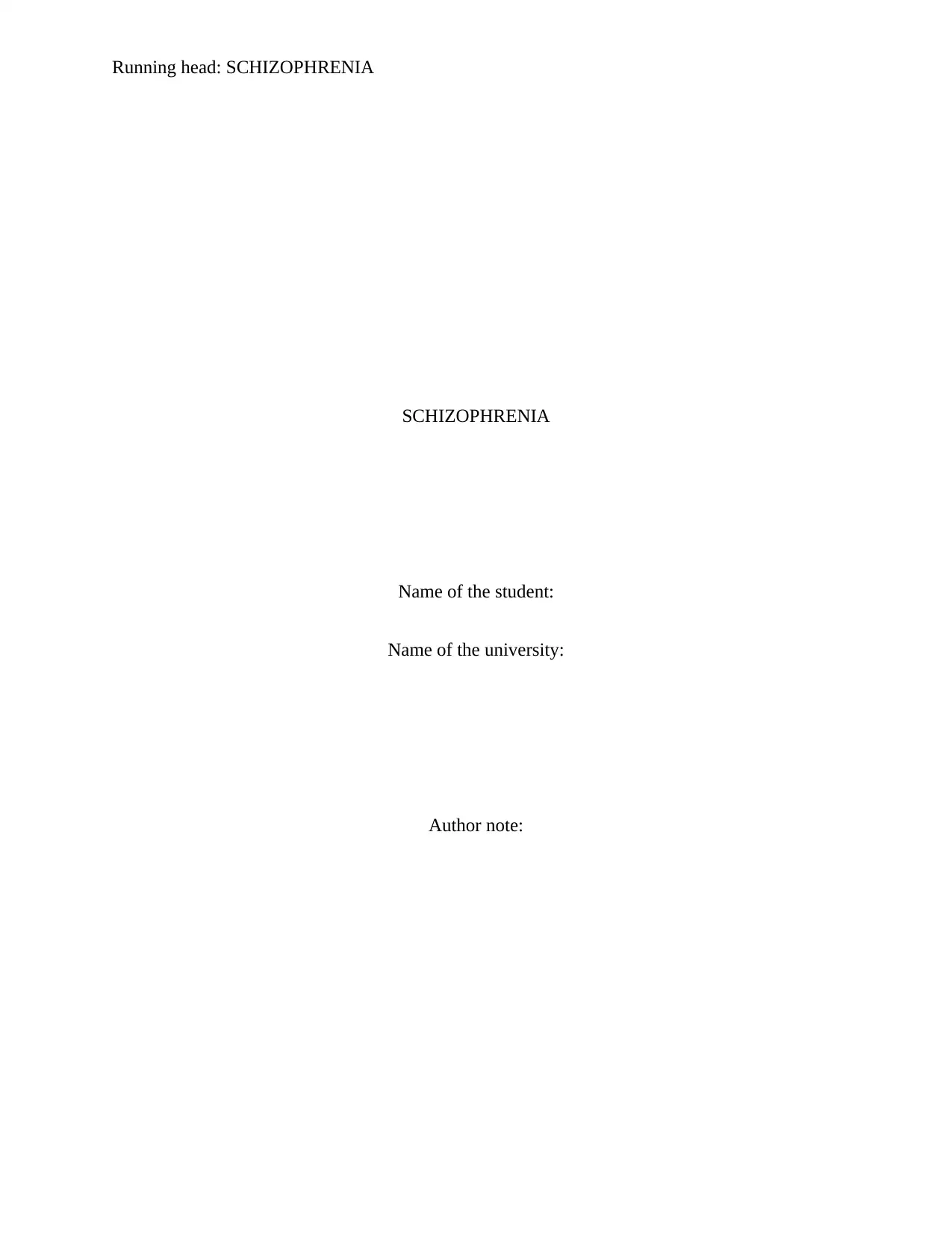
Running head: SCHIZOPHRENIA
SCHIZOPHRENIA
Name of the student:
Name of the university:
Author note:
SCHIZOPHRENIA
Name of the student:
Name of the university:
Author note:
Paraphrase This Document
Need a fresh take? Get an instant paraphrase of this document with our AI Paraphraser
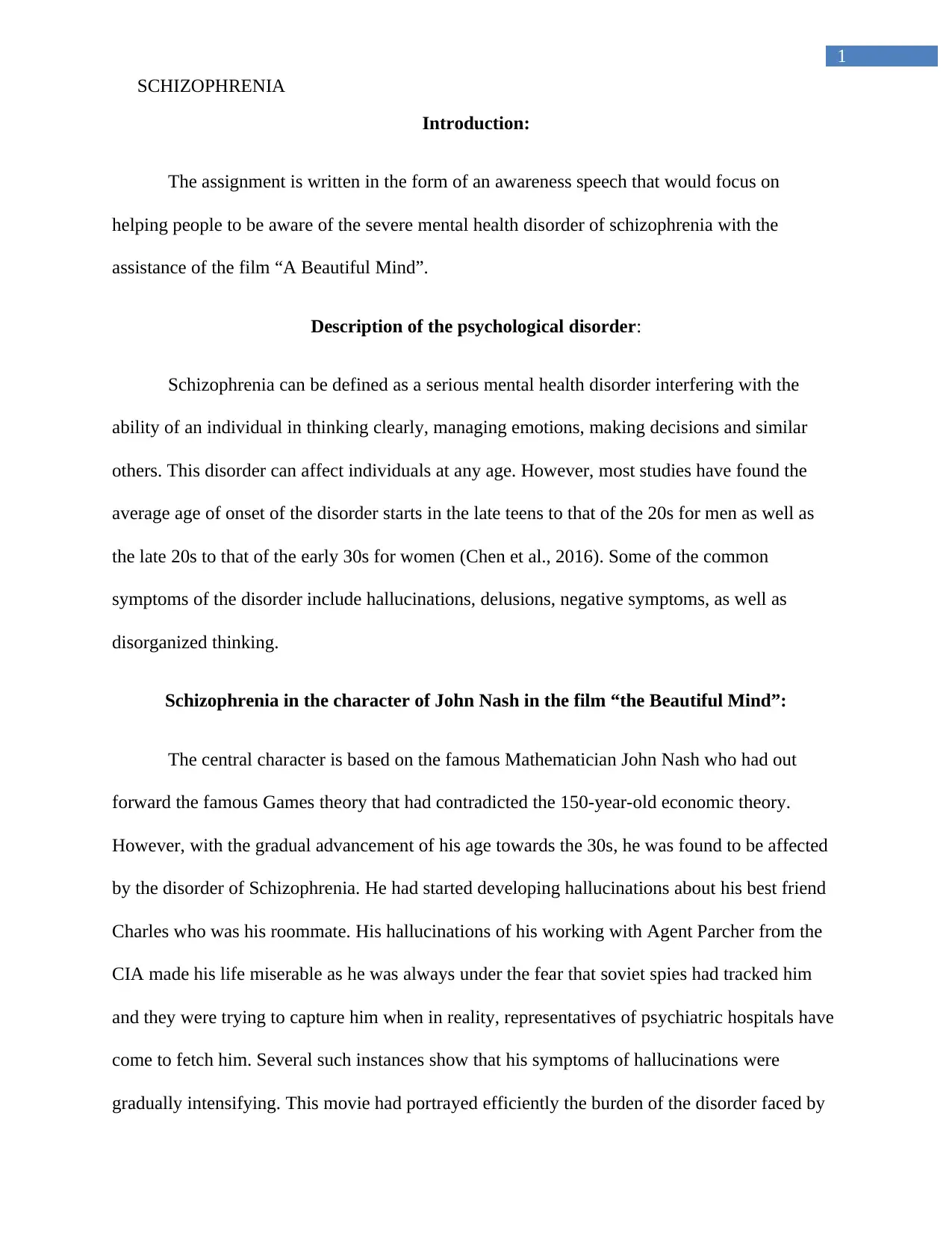
1
SCHIZOPHRENIA
Introduction:
The assignment is written in the form of an awareness speech that would focus on
helping people to be aware of the severe mental health disorder of schizophrenia with the
assistance of the film “A Beautiful Mind”.
Description of the psychological disorder:
Schizophrenia can be defined as a serious mental health disorder interfering with the
ability of an individual in thinking clearly, managing emotions, making decisions and similar
others. This disorder can affect individuals at any age. However, most studies have found the
average age of onset of the disorder starts in the late teens to that of the 20s for men as well as
the late 20s to that of the early 30s for women (Chen et al., 2016). Some of the common
symptoms of the disorder include hallucinations, delusions, negative symptoms, as well as
disorganized thinking.
Schizophrenia in the character of John Nash in the film “the Beautiful Mind”:
The central character is based on the famous Mathematician John Nash who had out
forward the famous Games theory that had contradicted the 150-year-old economic theory.
However, with the gradual advancement of his age towards the 30s, he was found to be affected
by the disorder of Schizophrenia. He had started developing hallucinations about his best friend
Charles who was his roommate. His hallucinations of his working with Agent Parcher from the
CIA made his life miserable as he was always under the fear that soviet spies had tracked him
and they were trying to capture him when in reality, representatives of psychiatric hospitals have
come to fetch him. Several such instances show that his symptoms of hallucinations were
gradually intensifying. This movie had portrayed efficiently the burden of the disorder faced by
SCHIZOPHRENIA
Introduction:
The assignment is written in the form of an awareness speech that would focus on
helping people to be aware of the severe mental health disorder of schizophrenia with the
assistance of the film “A Beautiful Mind”.
Description of the psychological disorder:
Schizophrenia can be defined as a serious mental health disorder interfering with the
ability of an individual in thinking clearly, managing emotions, making decisions and similar
others. This disorder can affect individuals at any age. However, most studies have found the
average age of onset of the disorder starts in the late teens to that of the 20s for men as well as
the late 20s to that of the early 30s for women (Chen et al., 2016). Some of the common
symptoms of the disorder include hallucinations, delusions, negative symptoms, as well as
disorganized thinking.
Schizophrenia in the character of John Nash in the film “the Beautiful Mind”:
The central character is based on the famous Mathematician John Nash who had out
forward the famous Games theory that had contradicted the 150-year-old economic theory.
However, with the gradual advancement of his age towards the 30s, he was found to be affected
by the disorder of Schizophrenia. He had started developing hallucinations about his best friend
Charles who was his roommate. His hallucinations of his working with Agent Parcher from the
CIA made his life miserable as he was always under the fear that soviet spies had tracked him
and they were trying to capture him when in reality, representatives of psychiatric hospitals have
come to fetch him. Several such instances show that his symptoms of hallucinations were
gradually intensifying. This movie had portrayed efficiently the burden of the disorder faced by

2
SCHIZOPHRENIA
caregivers while caring for loved people. Alicia was John’s wife and she felt burdened while
caring for her husband and her newborn at the same time. She was despondent over the fact that
her husband was no more like the way when she married him (Sideras et al., 2015). The struggles
that the schizophrenic central character went through and his journey until recovery is
phenomenal as it portrayed the various difficulties faced by an affected patient.
Description of the biological and environmental causes of the disorder:
Studies are of the opinion that certain biological factors like improper brain chemistry
and genetics are intricately associated with the disorder of schizophrenia. Issues with different
chemicals of the brain like neurotransmitters called glutamate and dopamine have been found to
be contributing to schizophrenia. These neurotransmitters are found to allow brain cells in
communicating with each other and improper functioning of these substances are believed to
cause the disorder. Many other studies believe that schizophrenia might occur among individuals
who have family members already suffering from psychosis. Evidence also suggests that certain
environmental factors like that of viral infection as well as exposure towards toxins like
marijuana trigger the development of the disorder (Catts et al., 2016). Besides, stressful life
events like bereavement, losing of job or home, ending of a relationship, divorce as well as
physical, sexual and emotional abuse also increases the chance of an individual to develop
schizophrenia.
Impact of psychological disorders on the mental health and well-being:
When left untreated, this disorder might result in huge number of problems that would be
affecting every areas of life. Some of the impacts are suicidal thoughts and self-injury incidents.
Affected individuals also develop anxiety disorders as well as obsessive-compulsory disorders.
SCHIZOPHRENIA
caregivers while caring for loved people. Alicia was John’s wife and she felt burdened while
caring for her husband and her newborn at the same time. She was despondent over the fact that
her husband was no more like the way when she married him (Sideras et al., 2015). The struggles
that the schizophrenic central character went through and his journey until recovery is
phenomenal as it portrayed the various difficulties faced by an affected patient.
Description of the biological and environmental causes of the disorder:
Studies are of the opinion that certain biological factors like improper brain chemistry
and genetics are intricately associated with the disorder of schizophrenia. Issues with different
chemicals of the brain like neurotransmitters called glutamate and dopamine have been found to
be contributing to schizophrenia. These neurotransmitters are found to allow brain cells in
communicating with each other and improper functioning of these substances are believed to
cause the disorder. Many other studies believe that schizophrenia might occur among individuals
who have family members already suffering from psychosis. Evidence also suggests that certain
environmental factors like that of viral infection as well as exposure towards toxins like
marijuana trigger the development of the disorder (Catts et al., 2016). Besides, stressful life
events like bereavement, losing of job or home, ending of a relationship, divorce as well as
physical, sexual and emotional abuse also increases the chance of an individual to develop
schizophrenia.
Impact of psychological disorders on the mental health and well-being:
When left untreated, this disorder might result in huge number of problems that would be
affecting every areas of life. Some of the impacts are suicidal thoughts and self-injury incidents.
Affected individuals also develop anxiety disorders as well as obsessive-compulsory disorders.
⊘ This is a preview!⊘
Do you want full access?
Subscribe today to unlock all pages.

Trusted by 1+ million students worldwide
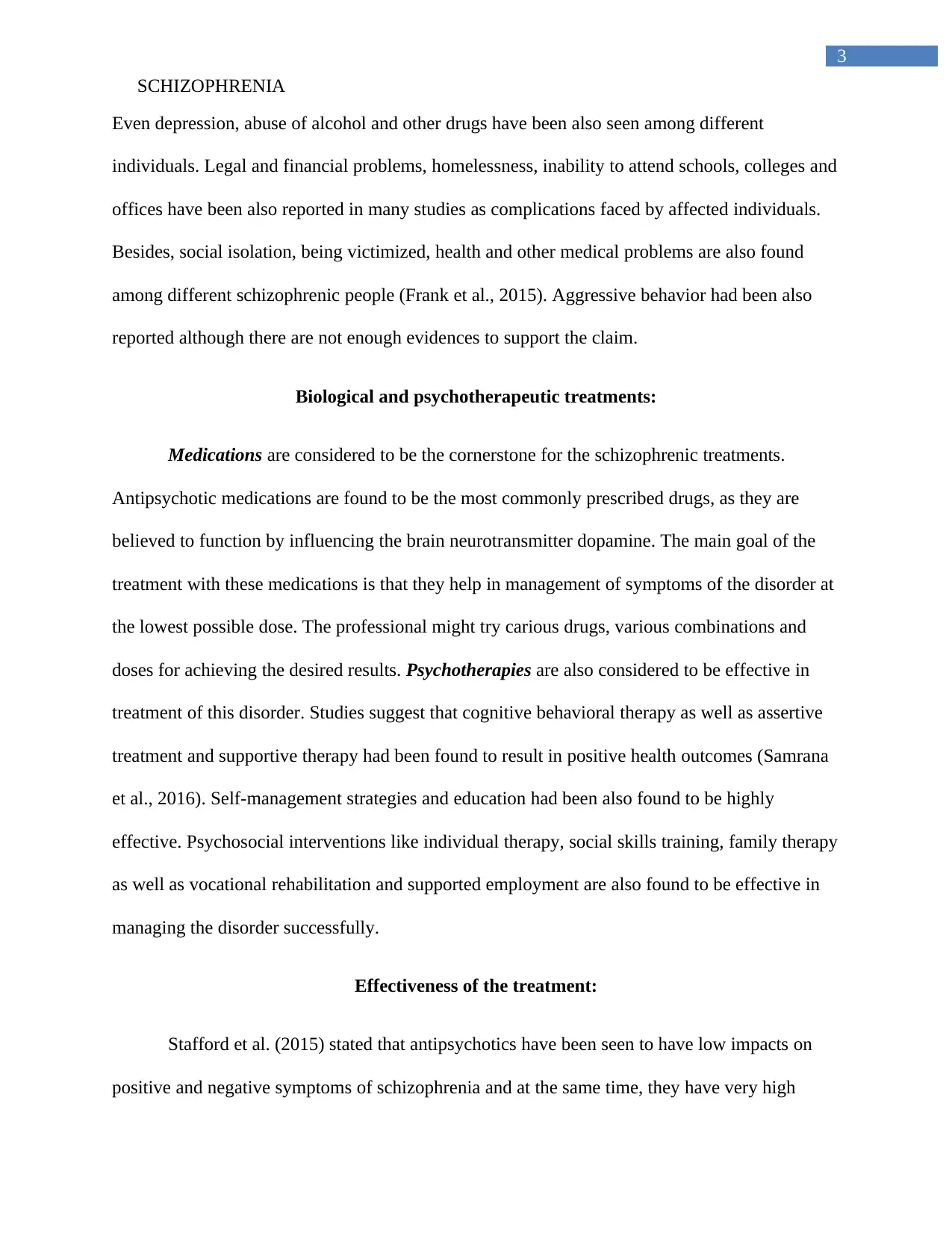
3
SCHIZOPHRENIA
Even depression, abuse of alcohol and other drugs have been also seen among different
individuals. Legal and financial problems, homelessness, inability to attend schools, colleges and
offices have been also reported in many studies as complications faced by affected individuals.
Besides, social isolation, being victimized, health and other medical problems are also found
among different schizophrenic people (Frank et al., 2015). Aggressive behavior had been also
reported although there are not enough evidences to support the claim.
Biological and psychotherapeutic treatments:
Medications are considered to be the cornerstone for the schizophrenic treatments.
Antipsychotic medications are found to be the most commonly prescribed drugs, as they are
believed to function by influencing the brain neurotransmitter dopamine. The main goal of the
treatment with these medications is that they help in management of symptoms of the disorder at
the lowest possible dose. The professional might try carious drugs, various combinations and
doses for achieving the desired results. Psychotherapies are also considered to be effective in
treatment of this disorder. Studies suggest that cognitive behavioral therapy as well as assertive
treatment and supportive therapy had been found to result in positive health outcomes (Samrana
et al., 2016). Self-management strategies and education had been also found to be highly
effective. Psychosocial interventions like individual therapy, social skills training, family therapy
as well as vocational rehabilitation and supported employment are also found to be effective in
managing the disorder successfully.
Effectiveness of the treatment:
Stafford et al. (2015) stated that antipsychotics have been seen to have low impacts on
positive and negative symptoms of schizophrenia and at the same time, they have very high
SCHIZOPHRENIA
Even depression, abuse of alcohol and other drugs have been also seen among different
individuals. Legal and financial problems, homelessness, inability to attend schools, colleges and
offices have been also reported in many studies as complications faced by affected individuals.
Besides, social isolation, being victimized, health and other medical problems are also found
among different schizophrenic people (Frank et al., 2015). Aggressive behavior had been also
reported although there are not enough evidences to support the claim.
Biological and psychotherapeutic treatments:
Medications are considered to be the cornerstone for the schizophrenic treatments.
Antipsychotic medications are found to be the most commonly prescribed drugs, as they are
believed to function by influencing the brain neurotransmitter dopamine. The main goal of the
treatment with these medications is that they help in management of symptoms of the disorder at
the lowest possible dose. The professional might try carious drugs, various combinations and
doses for achieving the desired results. Psychotherapies are also considered to be effective in
treatment of this disorder. Studies suggest that cognitive behavioral therapy as well as assertive
treatment and supportive therapy had been found to result in positive health outcomes (Samrana
et al., 2016). Self-management strategies and education had been also found to be highly
effective. Psychosocial interventions like individual therapy, social skills training, family therapy
as well as vocational rehabilitation and supported employment are also found to be effective in
managing the disorder successfully.
Effectiveness of the treatment:
Stafford et al. (2015) stated that antipsychotics have been seen to have low impacts on
positive and negative symptoms of schizophrenia and at the same time, they have very high
Paraphrase This Document
Need a fresh take? Get an instant paraphrase of this document with our AI Paraphraser
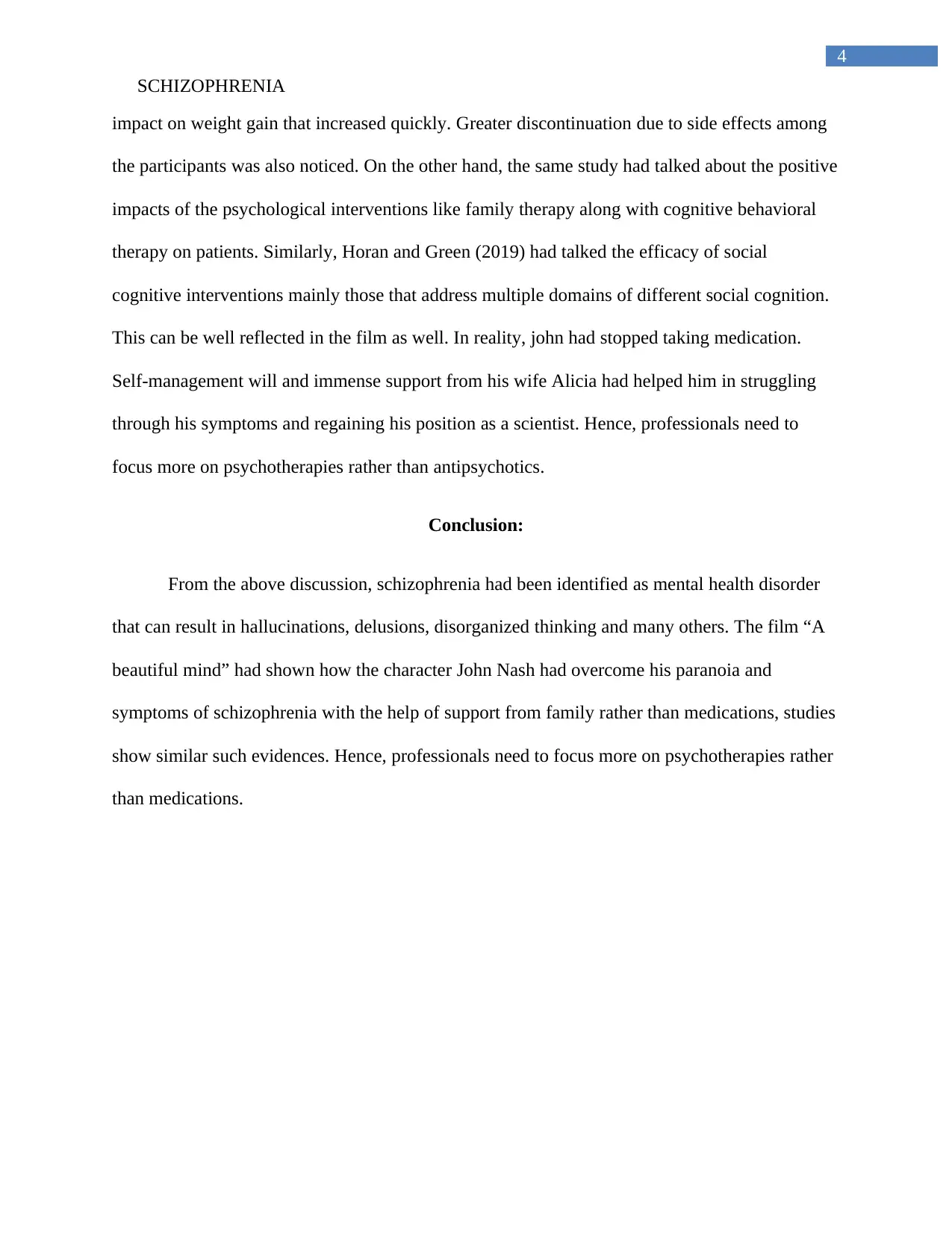
4
SCHIZOPHRENIA
impact on weight gain that increased quickly. Greater discontinuation due to side effects among
the participants was also noticed. On the other hand, the same study had talked about the positive
impacts of the psychological interventions like family therapy along with cognitive behavioral
therapy on patients. Similarly, Horan and Green (2019) had talked the efficacy of social
cognitive interventions mainly those that address multiple domains of different social cognition.
This can be well reflected in the film as well. In reality, john had stopped taking medication.
Self-management will and immense support from his wife Alicia had helped him in struggling
through his symptoms and regaining his position as a scientist. Hence, professionals need to
focus more on psychotherapies rather than antipsychotics.
Conclusion:
From the above discussion, schizophrenia had been identified as mental health disorder
that can result in hallucinations, delusions, disorganized thinking and many others. The film “A
beautiful mind” had shown how the character John Nash had overcome his paranoia and
symptoms of schizophrenia with the help of support from family rather than medications, studies
show similar such evidences. Hence, professionals need to focus more on psychotherapies rather
than medications.
SCHIZOPHRENIA
impact on weight gain that increased quickly. Greater discontinuation due to side effects among
the participants was also noticed. On the other hand, the same study had talked about the positive
impacts of the psychological interventions like family therapy along with cognitive behavioral
therapy on patients. Similarly, Horan and Green (2019) had talked the efficacy of social
cognitive interventions mainly those that address multiple domains of different social cognition.
This can be well reflected in the film as well. In reality, john had stopped taking medication.
Self-management will and immense support from his wife Alicia had helped him in struggling
through his symptoms and regaining his position as a scientist. Hence, professionals need to
focus more on psychotherapies rather than antipsychotics.
Conclusion:
From the above discussion, schizophrenia had been identified as mental health disorder
that can result in hallucinations, delusions, disorganized thinking and many others. The film “A
beautiful mind” had shown how the character John Nash had overcome his paranoia and
symptoms of schizophrenia with the help of support from family rather than medications, studies
show similar such evidences. Hence, professionals need to focus more on psychotherapies rather
than medications.
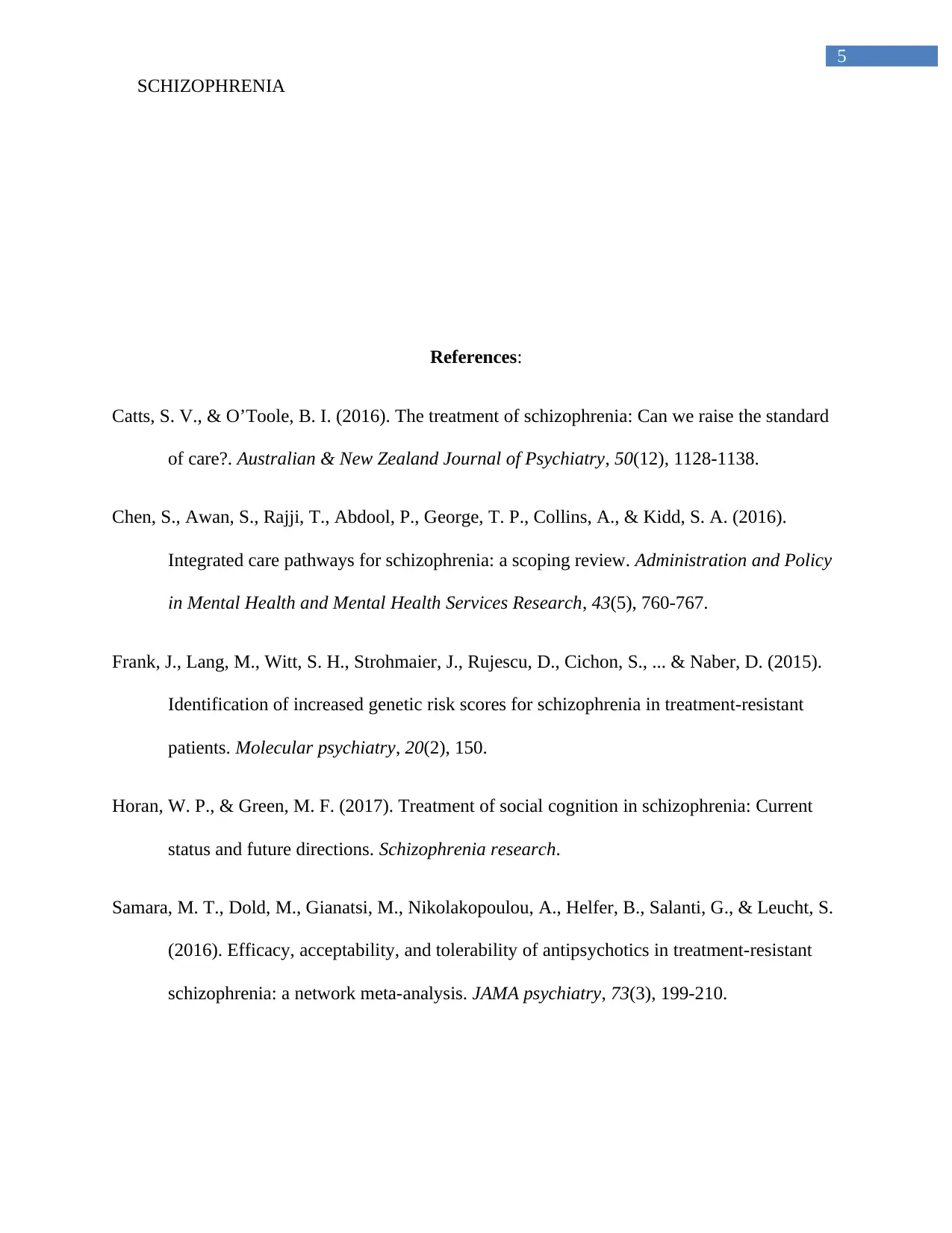
5
SCHIZOPHRENIA
References:
Catts, S. V., & O’Toole, B. I. (2016). The treatment of schizophrenia: Can we raise the standard
of care?. Australian & New Zealand Journal of Psychiatry, 50(12), 1128-1138.
Chen, S., Awan, S., Rajji, T., Abdool, P., George, T. P., Collins, A., & Kidd, S. A. (2016).
Integrated care pathways for schizophrenia: a scoping review. Administration and Policy
in Mental Health and Mental Health Services Research, 43(5), 760-767.
Frank, J., Lang, M., Witt, S. H., Strohmaier, J., Rujescu, D., Cichon, S., ... & Naber, D. (2015).
Identification of increased genetic risk scores for schizophrenia in treatment-resistant
patients. Molecular psychiatry, 20(2), 150.
Horan, W. P., & Green, M. F. (2017). Treatment of social cognition in schizophrenia: Current
status and future directions. Schizophrenia research.
Samara, M. T., Dold, M., Gianatsi, M., Nikolakopoulou, A., Helfer, B., Salanti, G., & Leucht, S.
(2016). Efficacy, acceptability, and tolerability of antipsychotics in treatment-resistant
schizophrenia: a network meta-analysis. JAMA psychiatry, 73(3), 199-210.
SCHIZOPHRENIA
References:
Catts, S. V., & O’Toole, B. I. (2016). The treatment of schizophrenia: Can we raise the standard
of care?. Australian & New Zealand Journal of Psychiatry, 50(12), 1128-1138.
Chen, S., Awan, S., Rajji, T., Abdool, P., George, T. P., Collins, A., & Kidd, S. A. (2016).
Integrated care pathways for schizophrenia: a scoping review. Administration and Policy
in Mental Health and Mental Health Services Research, 43(5), 760-767.
Frank, J., Lang, M., Witt, S. H., Strohmaier, J., Rujescu, D., Cichon, S., ... & Naber, D. (2015).
Identification of increased genetic risk scores for schizophrenia in treatment-resistant
patients. Molecular psychiatry, 20(2), 150.
Horan, W. P., & Green, M. F. (2017). Treatment of social cognition in schizophrenia: Current
status and future directions. Schizophrenia research.
Samara, M. T., Dold, M., Gianatsi, M., Nikolakopoulou, A., Helfer, B., Salanti, G., & Leucht, S.
(2016). Efficacy, acceptability, and tolerability of antipsychotics in treatment-resistant
schizophrenia: a network meta-analysis. JAMA psychiatry, 73(3), 199-210.
⊘ This is a preview!⊘
Do you want full access?
Subscribe today to unlock all pages.

Trusted by 1+ million students worldwide
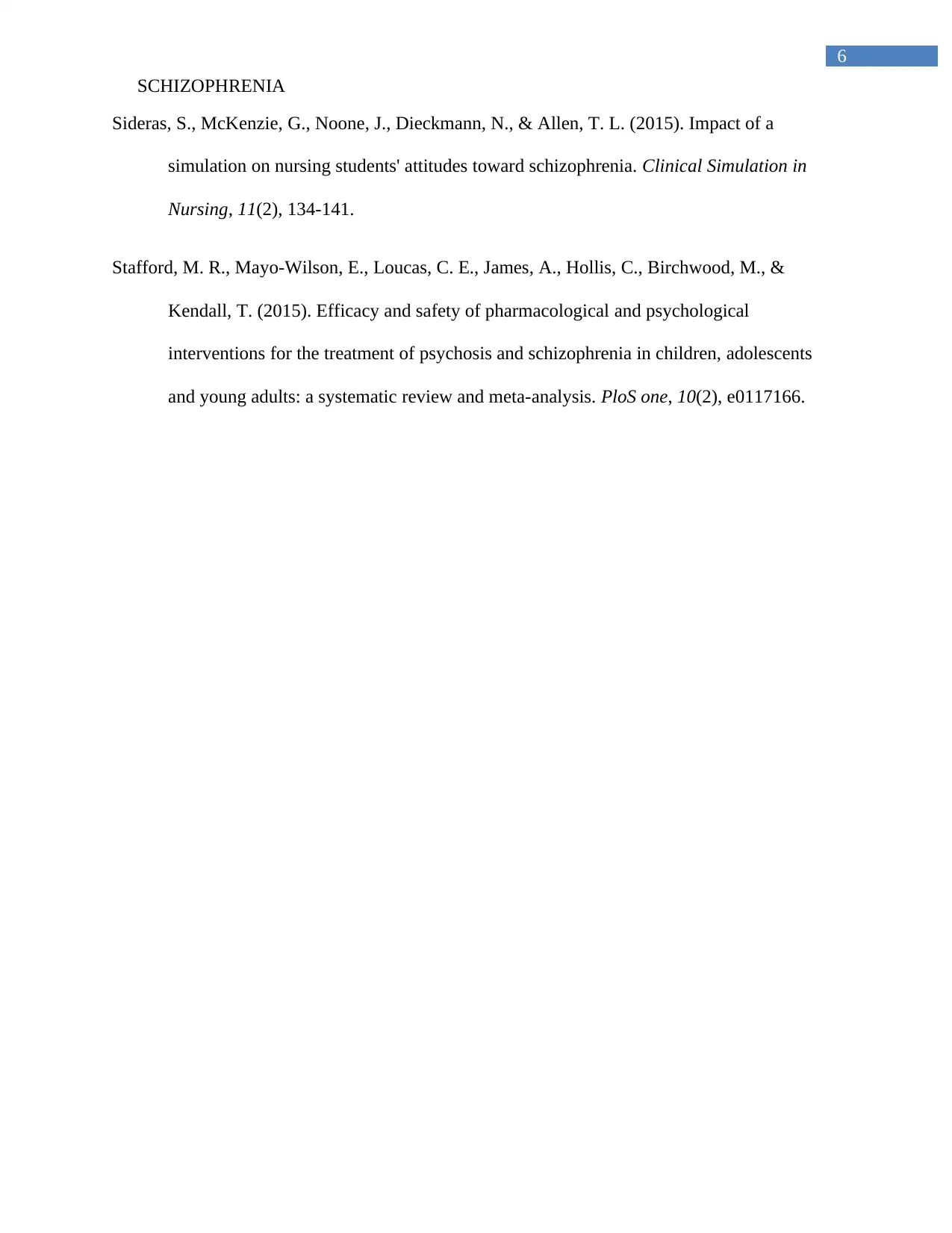
6
SCHIZOPHRENIA
Sideras, S., McKenzie, G., Noone, J., Dieckmann, N., & Allen, T. L. (2015). Impact of a
simulation on nursing students' attitudes toward schizophrenia. Clinical Simulation in
Nursing, 11(2), 134-141.
Stafford, M. R., Mayo-Wilson, E., Loucas, C. E., James, A., Hollis, C., Birchwood, M., &
Kendall, T. (2015). Efficacy and safety of pharmacological and psychological
interventions for the treatment of psychosis and schizophrenia in children, adolescents
and young adults: a systematic review and meta-analysis. PloS one, 10(2), e0117166.
SCHIZOPHRENIA
Sideras, S., McKenzie, G., Noone, J., Dieckmann, N., & Allen, T. L. (2015). Impact of a
simulation on nursing students' attitudes toward schizophrenia. Clinical Simulation in
Nursing, 11(2), 134-141.
Stafford, M. R., Mayo-Wilson, E., Loucas, C. E., James, A., Hollis, C., Birchwood, M., &
Kendall, T. (2015). Efficacy and safety of pharmacological and psychological
interventions for the treatment of psychosis and schizophrenia in children, adolescents
and young adults: a systematic review and meta-analysis. PloS one, 10(2), e0117166.
1 out of 7
Related Documents
Your All-in-One AI-Powered Toolkit for Academic Success.
+13062052269
info@desklib.com
Available 24*7 on WhatsApp / Email
![[object Object]](/_next/static/media/star-bottom.7253800d.svg)
Unlock your academic potential
Copyright © 2020–2025 A2Z Services. All Rights Reserved. Developed and managed by ZUCOL.



